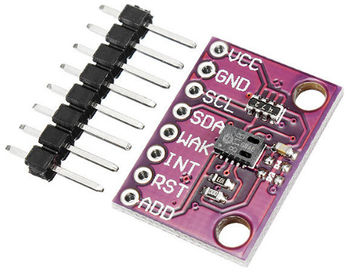CJMCU-811
| Project CJMCU-811 | |
|---|---|

| |
| Playing around with a breakout board for the CSS-811 IC | |
| Status | Initializing |
| Contact | bertrik |
| Last Update | 2019-01-03 |
Introduction
I bought this board from Aliexpress, it's a breakout board for the AMS CCS-811. The CCS-811 is an ultra-low power digital gas sensor for monitoring indoor air quality.
It appears what they accomplished is integration of a metal-oxide gas sensor into a tiny package so it uses very little power and has a fast response. For example, the well-known MQ-135 typically uses 750 mW just for heating the sensitive layer.
The datasheet can be found here.
It is unclear what it measures exactly. It appears to be sensitive to temperature and humidity levels too, although the chip provides a way to let it know the humidity and temperature so it can compensate for it.
Hardware
Pins on the breakout board:
- VCC this is directly connected to the IC (there is no voltage regulator on board), connect this to 3.3V
- GND to ground obviously
- SCL signal from I2C
- SDA signal from I2C
- WAK this needs to be low (!) in order for the chip to be active
- INT can be left unconnected
- RST can be left unconnected
- ADD can be left unconnected (?)
My board was apparently configured at I2C address 0x5A. I'm wiring it up to a Wemos D1 mini board with an ESP8266.
There is a firmware update available for the microcontroller inside the CCS811. My board shipped with the V1.1 version, I flashed it to the V2.0 version with this firmware updater by Maarten Pennings.
Software
I found two libraries (in order of preference, top one most likely to use):
It looks like the Sparkfun is the most useful of the two.
Interesting project using it together with a BME280:
- https://github.com/codmpm/esp-ccs811-bme280-mqtt
- https://github.com/sparkfun/SparkFun_CCS811_Arduino_Library/blob/master/examples/Example2_BME280Compensation/Example2_BME280Compensation.ino
Application to air quality monitoring at RevSpace
A sensor like this could be used to monitor indoor air quality at Revspace.
In general, we could monitor the air quality of the main room (for example).
In particular, we could use a sensor like this to monitor emissions from our 3d printers or our laser cutter.
Some reading material:
- Sara HÖgdahl, "Placing VOC Sensors for Assessing Air Quality - A CFD Study of Indoor VOC Distribution", MJ243X Degree project in Sustainable Buildings, second level, 2018-06-13, Stockhom.
- Ultrafine particles from 3d printing: https://www.3ders.org/images2016/new-study-shows-that-3d-printing-in-confined-spaces-can-be-bad-for-your-health-3.jpg
- Volatile organic compounds from 3d printing: https://www.3ders.org/images2016/new-study-shows-that-3d-printing-in-confined-spaces-can-be-bad-for-your-health-4.jpg